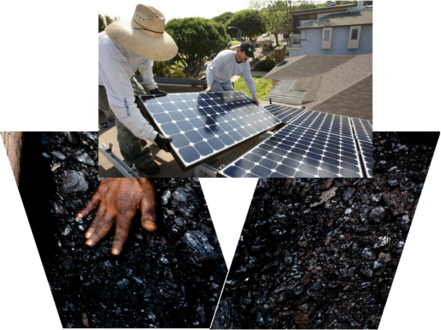Solar Halves Coals

Coal has been king of power generation for over a century, beginning with steam engines and moving into utility power plants. Natural gas had been the heir apparent to the fossil fuel crown since the 60’s, it even donned the crown for the first time in 2016. Today there is a new contender for the power generation throne in the form of the distributed technology of solar power. On the utility scale solar has reached half the price of coal. Albeit this is on the world market and utility scale. This is quite the achievement and the best part is that it can get even better because solar is not relegated to only utility adoption. It can be installed on homes and businesses!
The installation costs of of solar has fallen over 50% just in the last 6 years. Financing options and investment potentials continue to grow, providing easier adoption across the board. Systems are also becoming more intricate through the addition of storage technologies, which are also becoming more and more affordable themselves, making them more stand alone. Lightening the load on the infrastructure of the utility grid allowing it toe redirect its funds to drop the costs of going solar so it can mimic the world market pricing. The residential and business portions of the power model are looked at separately from the utility scale costs, but have the potential of becoming equivalent to utility power generation through incorporating it as a virtual power plant based on over production capability. Intertwining the cost savings for utilities and encouragement of solar adoption. So the age of fossil fuels is truly waning as distributed power waxes.
At the moment renewable only make up 16.9% of power generation in the US leaving a vast amount of space to gain further affordability as the technology continues to advance. The critical advantage that solar has within this sector is the distribution ability it contains. Since there is no pollution from its use it can be implemented on site, ideally on the unused roof space of buildings, with storage capacity added to it the system it can be more robust and extend its power saving ability into the night hours. An aspect that vitally accentuated in the world market for the developing regions of the African and Indian continents as well as remote regions everywhere. Established grids can take advantage of this through reducing the carbon footprint and alleviating climate damage, as long as they stop legislative blocks to solar. Continuing the monopoly is the single greatest threat to even more affordable power generation, although despite their efforts affordability continues to increase.
In The United States as the pricing is falling and adoption continuing to rise, special interests are making efforts to stifle growth. It is through the tremendous efforts of concerned people that utilities are pushed towards solar and renewable energy. The federal government gives a 30% income tax credit for homes and businesses that go solar and many states provide credits of their own. In Florida Amendment 4 just provided a 20 year sales and property tax exemption widening the doors of the nations 3rd highest solar potential region to truly become the sunshine state. More than these efforts it is the people reaching each other that has fueled its growth, putting investment in solar on par with utility power production. Showing that the trend to half the generation cost of coal in the US will be here soon.
The incentives of achieving world solar power generation cost halving that of coal are a standing testament of what can be accomplished. As more follow the example the installation costs will further lower the barrier of entry and accelerate production savings. The United States is turning towards solar power, meaning that 18% consumption of world energy it takes up will create the biggest attenuator on the production cost drop. There are governmental incentives to push renewable including solar that people are taking advantage, we just need to expand the number of those using them. At the same time keeping the monopoly interests at bay. It has been shown that halving the cost of world’s number one fossil fuel is possible and we can do even better by following the example and locally add rooftop solar in conjunction with pushing the utilities to install solar instead of fossil fuel power plants.
Go forth and spread sunshine,
Clifford Mitchem
Independent Energy Advisor
Clean Renewable Energy Worldwide
